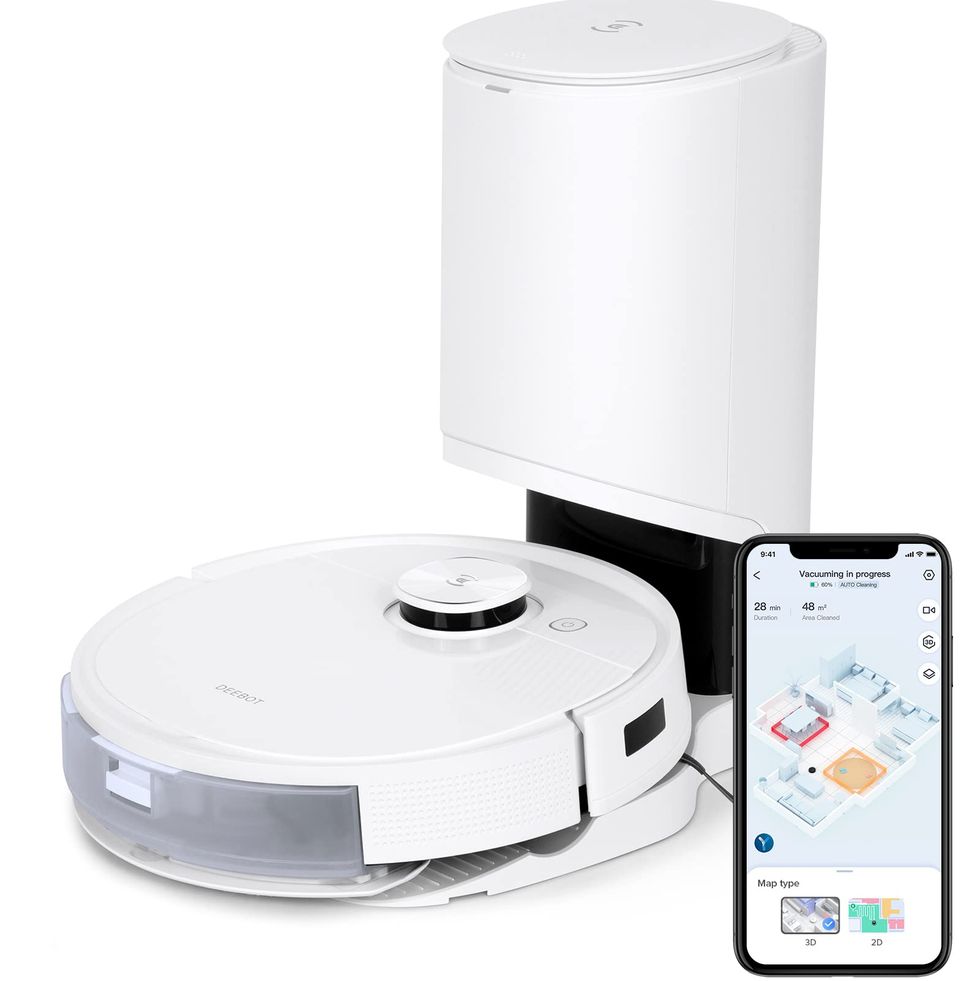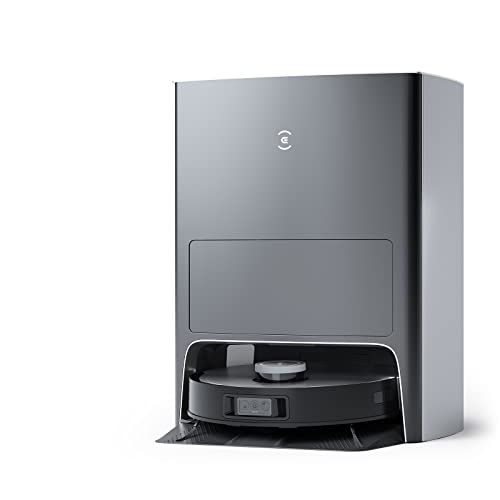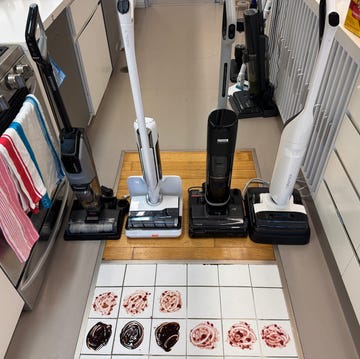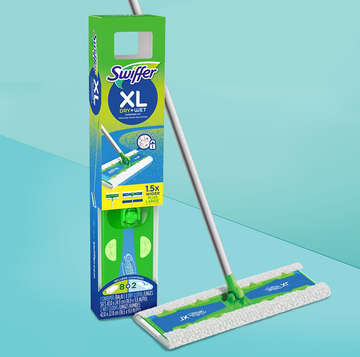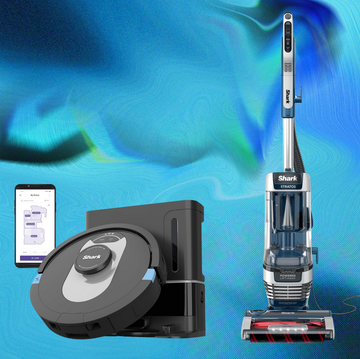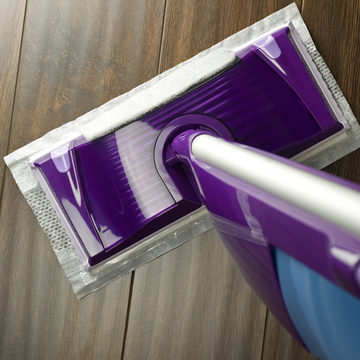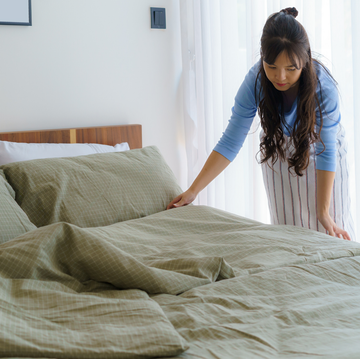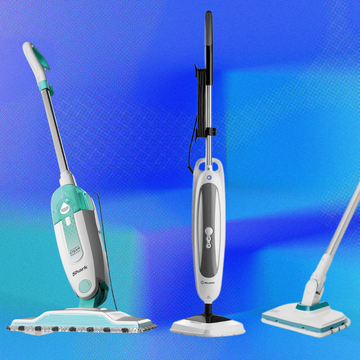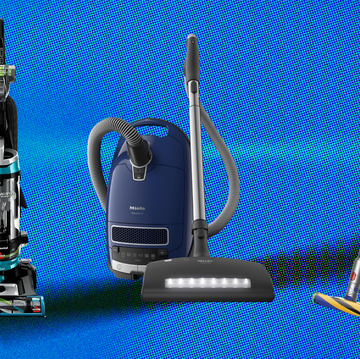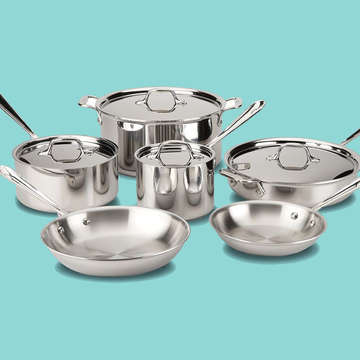7 Best Robot Mops, Tested by Cleaning Pros
A robot can save you time by handling the grime.

We've been independently researching and testing products for over 120 years. If you buy through our links, we may earn a commission. Learn more about our review process.
While using a traditional mop to scrub your floors may be the most conventional way to make them shine, doing so on a regular basis can be a real chore. Robot mops can help keep your hardwood, tile or laminate flooring clean while saving you time and energy. While robots don’t clean deeply enough to eliminate manual cleaning altogether, they can seriously lessen the burden of maintaining your floors. Just like our favorite robot vacuums, the best robot mops can spiff up your space, allowing you to put your mop away longer between manual cleaning sessions. Their hands-off approach to picking up dust and crumbs is a lifesaver if you have children or pets.
Experts in the Good Housekeeping Institute Home Care & Cleaning Lab test all kinds cleaning products, tools and appliances. We selected these models based on years of data gathered from testing cleaning robots. When choosing our favorites, we consider factors like ease of use, how effectively they lift stains and spills and how quickly they can get the job done. With helpful features like obstacle detection and avoidance, self-changing mop pads and scheduled cleaning, these robots can minimize the time you spend scrubbing your floors.
Pros
Cleans up to 1,000 square feet on a single charge
Can be paired with many iRobot vacuums
Square shape gets deep into corners
Cons
Sweeps but doesn't vacuum
We've tested many models from iRobot, including the j7+ Roomba Combo vacuum and mop and an earlier version of this mopping model, and they always fare well in our Lab tests.
The Braava Jet M6 robot mop is the perfect partner to the brand’s large selection of robot vacuums. Online reviewers love its quiet and effective cleaning. With overwhelmingly positive online reviews from consumers, plus our experts’ testing experience, we chose to include this new version of an old favorite as our best overall robot mop pick.
Its square design helps the Braava reach deep into corners and mop along baseboards. Because it can be used with warm water, it can more easily loosen dirt and stains, leaving floors cleaner. When the battery runs low or the water tank is empty, the Braava returns to its charging dock and then resumes cleaning once it is ready to go out again. On a single charge, it can clean up to 1,000 square feet. Afterward, removing the mopping pads is easy.
Note that this robot won't vacuum your floors, but if you already own an S, J, I or 900 series Roomba, you can pair them so the Braava automatically starts mopping when your robot vac has finished. If you want to keep it simple, this model can also sweep your floors. Disposable electrostatic pads allow it to pick up dust and dry debris. When the sweeping pads are installed, the M6 will not dispense any water onto your floors.
| Robot height | 3.5 in. |
| Mopping pad type | Disposable pads and reusable microfiber pads |
| Notable features | Virtual keep out zones, voice commands with Alexa or Google Assistant, charge and resume, can be programmed to mop after Roomba vacuums |
| Dry cleaning mode | Dry-sweeping |
| Battery life | 150 min |
Pros
Lab tests found it ran for over 180 minutes
Aced our pet hair pick-up tests
Covered floors multiple times when mopping
Includes a HEPA filter
Cons
Mopping pad does not lift automatically
Struggles with removing heavy debris from carpets
If you have a lot of floor space to cover, you'll need a model with a long runtime. When we tested the T20+ in our Lab, we found that it ran for over 3 hours on a single charge.
Its LiDAR navigation system can save up to three maps. The self-emptying base holds a 3.5 L dust bag designed to hold 60 days of dirt and debris. While the robot's water tank holds just 340 mL, that doesn't affect its mopping performance. In our tests, the T20+ still covered our floors multiple times and was able to navigate smoothly along edges and avoid obstacles. Note that this unit isn't able to raise the mopping pad when it detects carpet. The brand also recommends you remove the mopping pads when vacuuming hardwood floors to help avoid water damage.
In our dry cleaning tests, its wide brush did a great job of cleaning bare floors, and it excelled at removing pet hair from carpet. However, we did find that the robot struggled to remove heavier hard debris from carpet. Despite this, we like that the robot has a HEPA filter and that it automatically returns to the charging base when its battery is low. You can control it via a remote, voice assistant or app where you can set cleaning schedules, modes and suction levels as well as no-go zones and virtual walls.
| Robot height | 3.7 in. |
| Mopping pad type | Reusable cloth |
| Notable features | LiDAR navigation system, long runtime, self-emptying, HEPA filter, automatically returns to charging base when battery is low |
| Dry cleaning mode | Vacuuming |
| Battery life | 180 min |
Pros
Doesn't require emptying dirty water tank
Doesn't use water or electricity for cleaning mop pads
Cleans very quickly
Cons
Occasionally leaves water droplets behind
While many robot mops use reusable mopping pads, and some even have docks that wash and dry them, the Noesis Florio has a different approach. It uses disposable pads, and it automatically changes them when they become too dirty.
The Florio is a 2-in-1 vacuum and mop, and it navigated our two-room testing enclosure faster than many of the other units we've evaluated. The vacuum did a great job priming the floors for mopping, removing 96% of dirt on average in our bare floor tests. You can set it to vacuum and mop at the same time, or perform them separately. In our testing, we did notice that the Florio occasionally leaves droplets of water behind as it mops, so be careful not to walk behind it unless you like wet socks.
This model discards its used mopping pads, so you don't need to worry about washing them manually. It drops the dirty pads into a waste drawer at the end of their lifespan, and you can control exactly how often it changes the pad in the app. The base automatically empties the robot's dustbin too. The larger dust bag in the base only needs to be replaced every few weeks, and the base refills the water tank in the robot from a larger reservoir too.
| Robot height | 3.8 in. |
| Mopping pad type | Disposable pads |
| Notable features | Self-changing mop pads, recharge and resume, self-emptying dustbin, carpet detection, schedule cleaning and zone cleaning |
| Dry cleaning mode | Vacuum |
| Battery life | 180 min |
Pros
Base washes and dries the mopping pads after a cleaning task
Floor cleaning solution is included
Easy-to-use app with robust features
Excelled at cleaning up sticky stains in our Lab tests
Cons
Can only lift mop pad by 7 mm on carpet
If you find yourself constantly cleaning paw prints and picking up pet hair, consider Dreame's L10s Ultra robot vacuum and mop. This model is an updated version of the L10 we previously included in this guide, and it was just as impressive as the original in our Lab tests. Up against 10 of its self-emptying counterparts, it earned the second-highest overall maneuverability score.
While some robot mops only use water, the L10s has a separate compartment for cleaning solution. The bottle attaches inside the charging dock, where it automatically dispenses the right amount onto the mopping pads before a cleaning session. In our mopping trials, we saw a noticeable lightening of sticky stains after a single pass — something no other robot achieved in that round of testing. When the robot returns to the base, it automatically empties the bin and begins washing and drying the pads.
When the robot moved onto our test rug, it quickly raised the mopping pad enough to prevent dampening it. That said, it is only able to lift the pad by 7 millimeters, which might not be enough for plush carpeting. Once on the rug, it almost entirely removed the faux pet hair we tested with. After self-emptying, no fur was left behind in the dustbin or stuck to the brush roll. In our ease-of-use tests, it received top marks for its user-friendly app, which allows users to schedule cleaning tasks, adjust water and suction levels and even view a live feed from the robot's onboard camera as it cleans.
RELATED: Best Robot Vacuums for Pet Hair
| Robot height | 3.8 in. |
| Mopping pad type | Reusable pads |
| Notable features | Cleans and dries mopping pads, voice control, recharge and resume, remote camera viewing through app, schedule cleaning, adjusts cleaning path for obstacles and room sensed, auto-boost suction on carpet |
| Dry cleaning mode | Vacuuming |
| Battery life | 210 min |
Pros
Fantastic mopping performance in our Lab tests
Charging base has a small footprint
Can view your home in 2D or 3D in the app
Optional air freshener pod
Cons
Skips carpets when mopping pads are installed
Can struggle to reach tight corners
When we tested this unit for our Best Cleaning & Organizing Awards, Ecovacs' T9+ had the best mopping performance of the six models we tested. Tough stains like chocolate syrup, lipstick and dry jelly were completely removed from our test floors after just one pass.
It uses a vibrating mechanism to scrub the floors. We noticed the vibrations were so strong that the entire robot shook as it moved through our test enclosure. Still, its vacuuming power wasn't compromised. While it did struggle a bit with the debris we sprinkled into tight corners, the rest of our test floors were almost entirely debris-free at the end of each trial. It successfully steered clear of small obstacles like a pair of shoes and a toy meant to mimic dog poop. If you also want this robot to clean carpets and rugs at home, you'll have to remove the mopping pads as it will avoid carpets while they are installed.
Like most other app-enabled robot mops, you can control the suction power and amount of water dispensed onto the mopping pads via the app and schedule cleanings for a later time. The map this model created of our obstacle course was one of the most accurate we've seen.
In the app, you can view, edit and label zones within your home. You can even see the furniture in your home in 3D. It took less than 8 minutes to clean up our obstacle course, so we think this is a great model for small homes as it can complete a small cleaning task much faster than any of the other models we tested. The charging dock is also incredibly space-efficient. In spite of that, it can still hold up to 60 days' worth of debris. This model also includes an air freshener pod you can install into the robot to release a pleasant, subtle scent as it winds its way through your home.
| Robot height | 3.7 in. |
| Mopping pad type | Disposable cleaning cloths |
| Notable features | Recharge and resume, 3D mapping, schedule cleaning, auto-boost suction when more debris detected, air freshener built-in |
| Dry cleaning mode | Vacuuming |
| Battery life | 180 min |
Pros
Extra-large water tanks and dust bag in base
Leaves hardwood floors nearly dry after mopping
Doesn't require an Amazon or Google Assistant device
Successfully cleaned under furniture without getting stuck
Cons
Sometimes goes around debris instead of picking it up
Some water spots remained after a second pass on kitchen floors
We tested the X1 Omni from Ecovacs at home for over a year and continue to be impressed by its performance. It has cleaned under couches, beds and dining room table legs without getting stuck even once.
On a few occasions, we noticed the robot went around small pieces of debris instead of picking them up, but these were infrequent and could be remedied by setting the robot to make a second pass for deeper cleaning of our test floors. In a home with hardwood floors throughout the living room and bedrooms, it mopped well without leaving behind streaks or excess moisture. Tiled kitchen floors were a little trickier. Some water spots remained even after a second deep cleaning pass.
The self-emptying charging dock also serves as a clean water reservoir, and it automatically washes the mopping pads when the robot returns from cleaning. Unlike other robot mops, you don’t need to own an Amazon or Google Assistant device to use voice commands. Just saying “OK, Yiko,” wakes up the X1 Omni, though sometimes it responds when we aren’t talking to it.
The Omni talks to you as it’s cleaning too, letting you know when the mopping pads need to be cleaned and alerting you when it is finished. With the app, you can control the suction power, the amount of water dispensed to the mopping pads, whether you want the robot to make one cleaning pass or two and set no-go zones and schedules for cleaning.
| Robot height | 4.1 in. |
| Mopping pad type | Reusable mopping pads |
| Notable features | Base washes mopping pads, recharge and resume, schedule cleaning, virtual no-go zones, zone cleaning, camera can be viewed through the app |
| Dry cleaning mode | Vacuuming |
| Battery life | 260 min |
Pros
Has extending side brush and mop for cleaning into edges
Can be connected directly to water line and drainage system
Cons
Expensive
Roborock's S8 MaxV Ultra is an updated version of the S7 Max Ultra, which we have previously tested and recommended. While we're still testing this model, we are impressed with its performance so far. It is a self-emptying robot vacuum and mop that cleans floors with sonic vibration technology.
In our tests, it wowed us with its extending side brush and rotating side mop, which allowed the robot to clean in tight corners and against the walls. It lifts its mop pads by 20 millimeters when it detects carpet, and it automatically adjusts the suction and mopping intensity according to the room it’s cleaning. No need to label rooms in the app either — the S8 can identify what room it is based on the furniture it observes while mapping.
Two tanks sit on top of the charging dock: one for clean water and another for dirty water. The base also contains a bag for dry debris and a small tank for holding cleaning solution. It automatically refills the robot with fresh water and cleaning solution, washes the mopping pad and can hold multiple days’ worth of debris, making the cleaning process even more hands-off. If you don't feel like filling and emptying water tanks, Roborock also offers a refill and drainage variant of the MaxV Ultra which trades in the water tanks for direct connections to a water line and drainage system.
If you are looking for a more affordable robot with a smaller footprint, you could consider the Roborock Q Revo. The base of the Q Revo has all of the same self-emptying and refilling abilities of the S8 MaxV Ultra. The Q Revo makes use of dual spinning pads rather than a large, broad mopping pad. Whichever model you choose, you can use the Roborock app to adjust the suction, choose different cleaning modes, set no-mop zones, track the robot’s cleaning route and set cleaning schedules for different rooms in your home.
| Robot height | 3.8 in. |
| Mopping pad type | Reusable vibrawash mop cloth |
| Notable features | Washes mopping cloth, recharge and resume, schedule cleaning, virtual no-go zones, zone cleaning, carpet detection |
| Dry cleaning mode | Vacuuming |
| Battery life | 180 min |
How we test robot mops

The Good Housekeeping Institute Cleaning Lab began testing cleaning robots all the way back in 2002. Since then, we have tested hundreds of robot vacuums and mops, putting each through rigorous performance and ease-of-use tests. On top of our Lab assessments, we have also collected data from dozens of consumer testers who have tried and reviewed models in their own homes.
When we test robot mops, we evaluate how effectively each device cleans up spills like sticky jelly and coffee dribbles applied to test floor panels installed in our Cleaning Lab. We also look at how much moisture it leaves behind on wood, vinyl and tile floors to assess any potential for water damage. If it has vacuuming or sweeping capabilities, we rely on testing procedures adapted from the International Electrotechnical Commission and ASTM International for testing robot vacuums.
We see how well the robots pick up debris in a straight line from bare floors and carpets, and we set each model loose in a custom-made two-room testing enclosure with obstacles. We evaluate how much debris each model picks up, how much time it takes to clean and how long each battery runs. We also consider how well each robot can clean under low furniture and around tight corners as well as how it passes from hard floors to carpet and how effectively it climbs small thresholds. For robots that create maps, we evaluate the maps for accuracy and level of detail.
In our ease-of-use evaluations, we rate each robot mop's user manual and how easy it is to use the controls and app. We also consider how long it takes to set up and how difficult maintenance activities are. At-home testers also provide feedback on how user-friendly the models are and whether they would continue using them or recommend them to others.
What to look for when shopping for the best robot mop

Here are some things to keep in mind when picking the best robot mop for your home:
✔️ Dry-sweeping vs. vacuuming: While some robot mops only work for wet cleaning, most you'll find on the market can do some type of dry cleanup as well. Some can vacuum your floors, and others only sweep using a dry pad. Combo models that double as vacuums will have the added task of emptying the dust bin after cleaning (unless they also have a self-emptying dock). Models that sweep will need the sweeping pads washed or discarded after each use. If your floors are particularly dusty, letting the device vacuum before mopping will yield better results.
✔️ Setup and maintenance: Maintaining a robot mop requires filling and emptying water tanks, removing or replacing the cleaning pads and charging the robot itself. Some models have features that make upkeep easier. The most hands-off models self-empty into a base that only needs to be emptied every 30 days or more, and some can even wash and dry their mop pads between uses. Most of the new models we’ve tested in the Cleaning Lab come with a QR code on the packaging for easier app setup too.
✔️ Battery life: We usually recommend models that can run for at least 90 minutes on a single charge. This is especially important if you have a large home. However, most robot mops now recharge and resume cleaning to finish the job if the battery starts to run low mid-cleaning, and if a robot is able to clean quickly, its battery runtime is less important.
✔️ Surface type: While vinyl and tile floors are generally pretty resistant to damage, you have to be more careful with hardwood floors. If you have them, be sure the robot mop you select is well-suited for that surface. Models that have brush rolls with hard bristles can scratch floors. Look for a robot that has a large, fluffy brush roll or one made of silicone or rubber. For mopping on wood floors, look for a model that allows you to adjust the amount of water that goes into the pads.
If your home also has rugs, choose a robot mop that can detect the difference between carpet and bare floors to avoid wetting your carpeting. Many models can lift the mopping pads a bit when they traverse onto carpet, but in homes with thick, plush floors, this isn't always enough. Check to make sure the pad will lift sufficiently to keep your carpet dry, or look for an app-enabled model that allows you to set no-go zones.
✔️ App integration: Most new robot mops and vacuums can be paired with an app to save maps of your home, set cleaning schedules or select cleaning modes. Some even let you see what your robot is up to while you are away. While not all robots require one to work, often the best features are only accessible through the app. If you’d prefer not to use an app, look for a model with a remote control, or consider one that allows you to begin a cleaning task from a button on the robot or its base.
Are robot mops worth it?

While robot mops won't eliminate mopping from your chore list altogether, they can help you keep up with your floors and deep-clean less often. They are a great investment for families with pets or small children, or anyone who wants to keep their floors clean without devoting a lot of energy to a manual cleaning routine. "Just like you can vacuum faster than a robot, you can probably mop faster than one too, but they are a convenient way to wet-clean and freshen floors while you do something else," said Home Care & Cleaning Lab Executive Director Carolyn Forté.
While most robot mops can detect obstacles and navigate around them, they work best when you straighten up the space before a mopping session. After all, you probably wouldn't mop with pet toys or socks strewn across the floor. For models that only mop, you'll still have to vacuum or sweep regularly to keep the floors primed for wet cleaning. Keep in mind that robot mops aren't designed for cleaning up big spills, so you will still need to handle those by hand. Heavily soiled floors may be challenging for robot mops to handle, but they help keep dirt from building up in the first place, so you have fewer deep cleanings to do.
"That said, though, robot mops can take longer to do the job than mopping by hand," said Forté. Some models come with a cleaning solution while others just use water. Mop pads range from rotating scrubbers to vibrating pads. While many models have impressive navigation and obstacle avoidance abilities, they still can get stuck on small obstacles or get confused in rooms crowded with furniture.
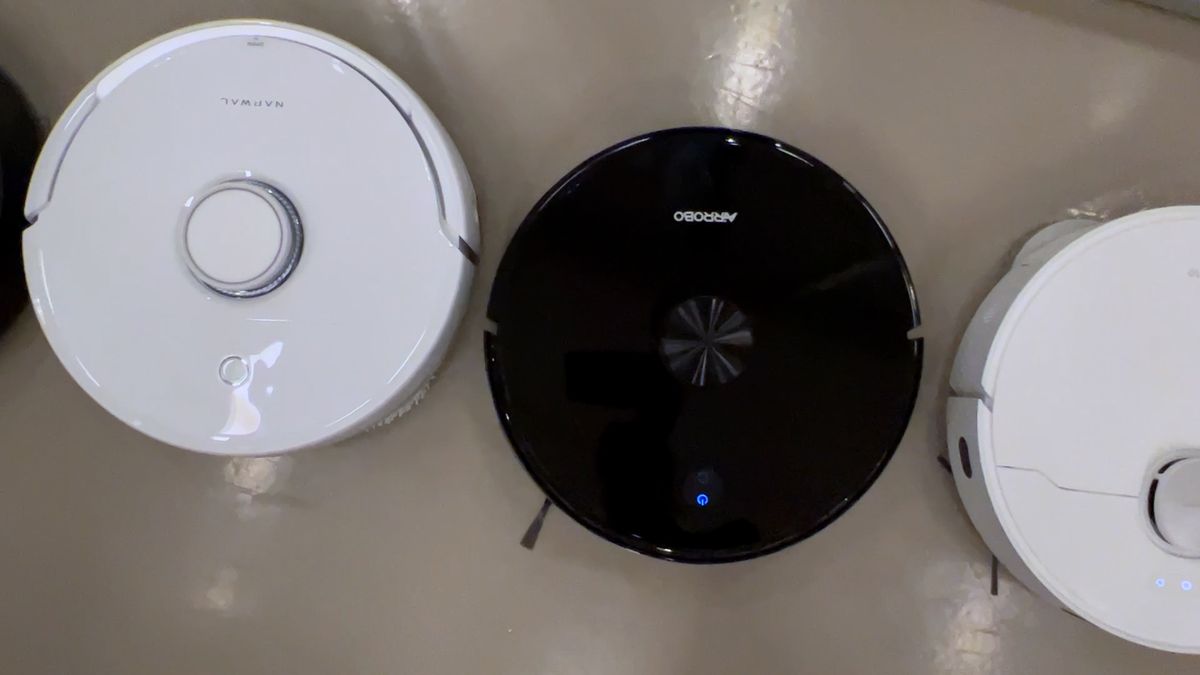
How to maintain a robot mop

Not unlike robot vacuums, robot mops need regular maintenance to keep them in working order and get the best cleaning results. This includes wiping the sensors for better navigation and regularly emptying and rinsing the water tank. If you have a combination vacuum and mop, be sure to regularly check the brush roll for clogs and hair tangles and clean or replace the filter.
Because these models also use water to clean, it's important to make sure the robot’s pads or mopping cloths don't remain wet for too long. Bacteria love moist, dark spaces, and if your robot mop doesn’t dry its mopping pads automatically, it’s best to remove and wash them (if the manufacturer says it is safe to do so) after every cleaning session. "If they aren’t dirty enough to be laundered, they should at least be rinsed and air-dried after each use to keep them from [becoming] musty during storage," recommended Forté. If you have a model with disposable pads, you won't have to worry about this issue.
For app-enabled robot mops, make sure to turn on automatic updates to ensure you are using the latest version. Software updates often improve a robot's navigation and object avoidance abilities. Most user manuals have thorough instructions for keeping robots in working order, and it is always best to follow those instructions before trying anything else.
Can you put vinegar in a robot mop?

To put it simply: No. "Unless your robot manufacturer recommends it, it’s never a good idea to put anything other than plain water inside an appliance as it can damage the internal parts," explained Forté. There is a chance you could void your model’s warranty. This doesn't mean you can only clean with water, though. Many brands like Shark, Bissell and Narwal make cleaning solutions formulated for use in their brand’s robot mops. We don't recommend using other floor cleaners in your robot mop’s water tank unless the manufacturer specifies that it's okay.
Why trust Good Housekeeping?

Noah Pinsonnault works as a product reviews analyst in the Home Care & Cleaning Lab where he helps design and perform tests on various product categories. To update this story, he evaluated several of the latest combo robot vacuum mops and pored over previous testing data to compare them to some our past favorites.
Carolyn Forté, the Good Housekeeping Institute's Home Care and Cleaning Lab Executive Director, has over 40 years of experience testing cleaning appliances. She tested one of the earliest models of cleaning robots in 2002 and oversees all of the testing conducted in the Lab, including all the robot mop picks in this story.
Noah works as a product reviews analyst in the Home Care & Cleaning Lab where he helps design and perform tests on various product categories. He draws on scientific expertise garnered during his time as an environmental researcher, where he managed environmental monitoring equipment, analyzed water samples in a lab and developed protocols for restoration projects. He holds a Bachelor’s Degree in environmental science from the University of Wisconsin-Superior.
Carolyn Forté brings more than 40 years of experience as a consumer products expert to her role as executive director of the Good Housekeeping Institute's Home Care and Cleaning Lab. Using deep analytical testing and writing expertise in appliances, cleaning, textiles and organizational products, she produces cleaning and home care advice for GH, has authored numerous books and bookazines for the brand and partners with the American Cleaning Institute to co-produce the Discover Cleaning Summits. She holds a bachelor's degree in family and consumer sciences from Queens College, City University of New York.






